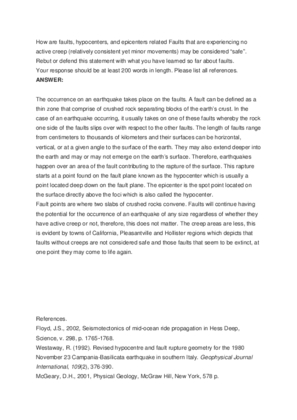How are faults, hypocenters, and epicenters related Faults that are experiencing no active creep (relatively consistent yet minor movements) may be considered
in Other (Other) by vommsYour Price: $5.00 (30% discount)
You Save: $2.14
Description
How are faults, hypocenters, and epicenters related Faults that are experiencing no active creep (relatively consistent yet minor movements) may be considered safe. Rebut or defend this statement with what you have learned so far about faults. Your response should be at least 200 words in length. Please list all references. ANSWER:
The occurrence on an earthquake takes place on the faults. A fault can be defined as a thin zone that comprise of crushed rock separating blocks of the earths crust. In the case of an earthquake occurring, it usually takes on one of these faults whereby the rock one side of the faults slips over with respect to the other faults. The length of faults range from centimeters to thousands of kilometers and their surfaces can be horizontal, vertical,...


